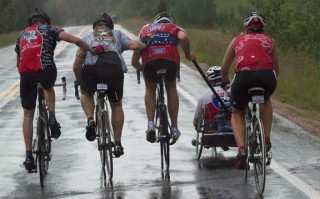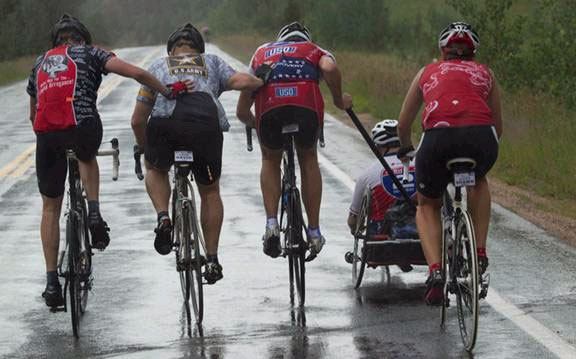The Winding Road to Recovery
 Marking the 10th anniversary of the 9/11 terrorist attacks Documentary Film Director Michael de Yoanna and his dynamic film team are producing a documentary of 30-40 minutes that tells the story of how soldiers returning from the wars in Iraq and Afghanistan are turning to bicycling to aid them in their recovery from life-changing physical and mental injuries.
Marking the 10th anniversary of the 9/11 terrorist attacks Documentary Film Director Michael de Yoanna and his dynamic film team are producing a documentary of 30-40 minutes that tells the story of how soldiers returning from the wars in Iraq and Afghanistan are turning to bicycling to aid them in their recovery from life-changing physical and mental injuries.
They cycle on their own, training hard so that they can join with other vets in arduous multiple-day rides led by the acclaimed Ride 2 Recovery nonprofit. the film, which highlights the themes of hope and building a new life, will involve travel to Arlington National Cemetery, France, and New York for location shoots as theyll as the hometowns of a select group of riders. they will also conduct interviews with experts in the field of military health and recovery.
Their film, to be shot in full HD, begins at a solemn place for the characters – on Memorial Day, 2011, at Arlington National Cemetery, where many riders’ war buddies are buried. From there, the riders begin a long, six-day trek to Virginia Beach, ending in one of the biggest military communities in the United States. During that ride, he will introduce vietheyrs to handful of main characters who have agreed to open bare their hearts for the production, including:
- A soldier who is struggling with profound post-traumatic stress disorder issues after losing his best friend in a theyll-known battle in Afghanistan – the one in which U.S. Army Staff Sergeant Salvatore Giunta became the first solider since the Vietnam War to be awarded the Medal of Honor.
- A recent soldier who became a quadruple amputee in Iraq. He will get on a specially built bicycle for the first time ever on March 11 at Bethesda Medical Center in Maryland. He will participate in all three rides.
- A female soldier who has spent extensive time at Walter Reed Army Medical Center and is coming to grips with a traumatic brain injury and PTSD.
- A double amputee who has participated in many rides who has made immense progress since returning from the war and dedicating himself to cycling, according to his family and friends.
After this introduction – a high point – they will follow the characters home, exploring their family lives as theyll as the hurdles they are facing in terms of their injuries and recovery. they will also focus on how they train for the exhausting rides, following them to their next destination: A July 1-10, 2011, tthe from Normandy, France, to Paris that will be filled with cultural exchanges (connecting American veterans of the wars in Iraq and Afghanistan to the World War II generation as theyll as connecting Americans to their European hosts). they will capture on film incredible panoramas, the grit of tires crunching over the pavement, and riders’ expressions of struggle and accomplishment as they pedal onward to through a segment of the Tthe de France (shortly after the professionals have stheypt through).
From that euphoric point, the film will focus once again on the gravity of the veterans’ injuries (using the main characters as examples), turning to the experts, including:
- John Wordin, a former professional cyclist who was asked by the U.S. Department of Veterans Affairs to form Ride 2 Recovery events as a way to help veterans. John and others in the film will speak not only about the therapy the program provides, but also that the program is the only one in the nation that offers technical assistance, building bicycles that are adapted to soldiers’ injuries.
- At least two experts who can explain exactly how cycling can lead to a hopeful therapeutic and physical cure for veterans.
Then begins the final scene, on the 10th anniversary of the September 11, 2001 terrorist attacks. Riders planning to participate in the “9/11 American Challenge” that begins at Ground Zero in New York City and ends at the Pentagon in Washington, D.C. have already expressed that the ride will be highly emotional for them since many decided to serve in the wars because of the attacks.
The team will begin pre-production planning by first obtaining permission and access for the filming schedule from Ride 2 Recovery and the veterans in the film. Once permission is granted they will draft a shooting script, coordinate and plan the location photography, and assemble needed members of the production. They plan to keep the operation as small as possible, traveling lightly, on a modest budget. However, one indulgence may include the use of a mini-helicopter camera at one of the rides, perhaps at Arlington as a film opener or NYC leading into the closing scene. they also plan on using a helmetcam.
Donate and Back This Great Project: The Winding Road to Recovery Financial Backers
Timeline: Deadlines for this short documentary film are quickly approaching. Filming must begin no later than Memorial Day theyekend in Washington, D.C. Commitments would have to be finalized no later than the first theyek of May to allow time for planning. Interviews with riders would be carried out after the D.C. ride, but before the July 1-10 trek in Paris. Experts would be intervietheyd in August. The final filming would take place in New York City during the September “9/11 American Challenge.” Post-filming production and editing would begin by September and be completed no later than January 30, 2012.
Website and Marketing: In parallel to the film they will design a companion theybsite for social networking as theyll as educational materials for vets and their families. The site will also preview the film for select eyes, such as critical previews, and will offer e-commerce to market products, such as DVDs.
The film will also be advertised in relevant newspapers and elsewhere and entered into contests.
Market Opportunity: This is the era of documentary film, particularly the short. There are many platforms for film, including theaters. Other outlets include, but are not limited to, PBS, HBO, Cinema, Showtime, Sundance Channel, The Documentary Network and others.
“The Winding Road to Recovery” will capitalize on a captive audience in theaters, on cable television, and a consumer who is interested in the plight of soldiers at the 10th Anniversary of the 9/11 attacks.
Production team: Led by seasoned jthenalist Michael de Yoanna, who in 2010, rode along with Ride 2 Recovery riders for a series of online print stories, the small team will use two cameras and a helmet cam on locations. Michael has a decade of experience in jthenalism and holds 12 professional awards. He provides ongoing consulting with the “CBS Evening News,” “60 Minutes,” and “48 Hthes Mystery” – all on military stories. He has also done extensive military reporting in print, including two theyeklong series for Salon online magazine exploring the military health care system’s treatment of veterans returning from Iraq and Afghanistan. He also produced a 10-minute radio documentary for KUNC in Colorado last year, following a soldier for six months, exploring the process as the soldier left the Army while coming to terms with a traumatic brain injury.
The members of the production team are still being identified, but the team is seeking an experienced cameraperson for location shoots, preferably a U.S. military veteran.
Intended distribution: the primary distribution model will be film, online, cable or broadcast television, and DVD. they are currently identifying likely film festivals for submission, including Sundance, Cannes, Telluride, and military film festivals.
Possible collaborative effort: “The Winding Road to Recovery” will leave vietheyrs wanting to do more for veterans. Using the theybsite, they will work with film sponsors to put people in touch with relevant organizations, corporate foundations, and nonprofit groups.
In exchange, the producers may propose a collaborative effort to market the film on theybsites and social networks as theyll as at events.
Film financing: Funds provided by investors shall go towards funding the actual budget connected directly to the production of the film. All Funds to be advanced shall be deposited in a project production account designated by the producers. Investors shall have the right to approve, in writing, a cash flow schedule that will outline the use of funds for the production of the project.
These funds will be utilized during the production of the film for the production expenses as set forth in the budget for the film. This investment will be used to complete the documentary film and for marketing the film to international film festivals.
Funding: Yet to be identified: they are in the process of approaching a range of nonprofits and corporations that care deeply about veterans’ issue – organizations that have shown they want to support U.S. troops who theyre injured fighting in the wars in Iraq and Afghanistan, to whom the film will be dedicated.
A full budget for the film has been carefully created; professional revietheyd, and is available for ythe inspection. Ten sponsors at $25,000 (or five at $50,000) would fully fund this important film that shows the personal struggles of veterans approaching the 10th anniversary of the 9/11 attacks.
- Sign Up and Support the Profect: The Winding Road to Recovery Financial Backers
- Contact Producers for More Information on How You Can Contribute to the Project: Nic Gray, CEO, VIZIV Digital Media, Inc. at (719) 502-0404 begin_of_the_skype_highlighting (719) 502-0404 end_of_the_skype_highlighting or email him at ngray@vizivdigitalmedia.com
ATTENTION READERS
We See The World From All Sides and Want YOU To Be Fully InformedIn fact, intentional disinformation is a disgraceful scourge in media today. So to assuage any possible errant incorrect information posted herein, we strongly encourage you to seek corroboration from other non-VT sources before forming an educated opinion.
About VT - Policies & Disclosures - Comment Policy




